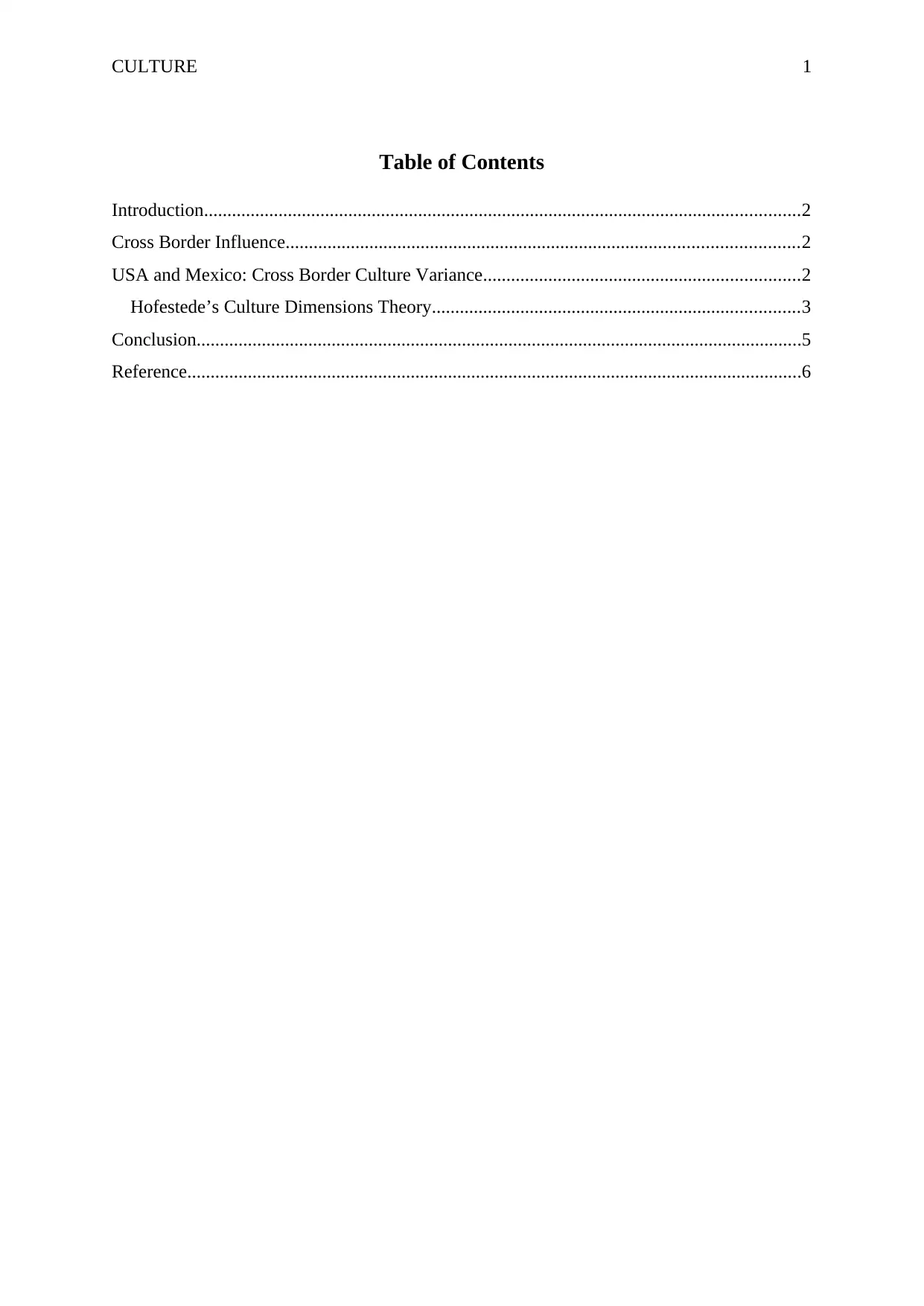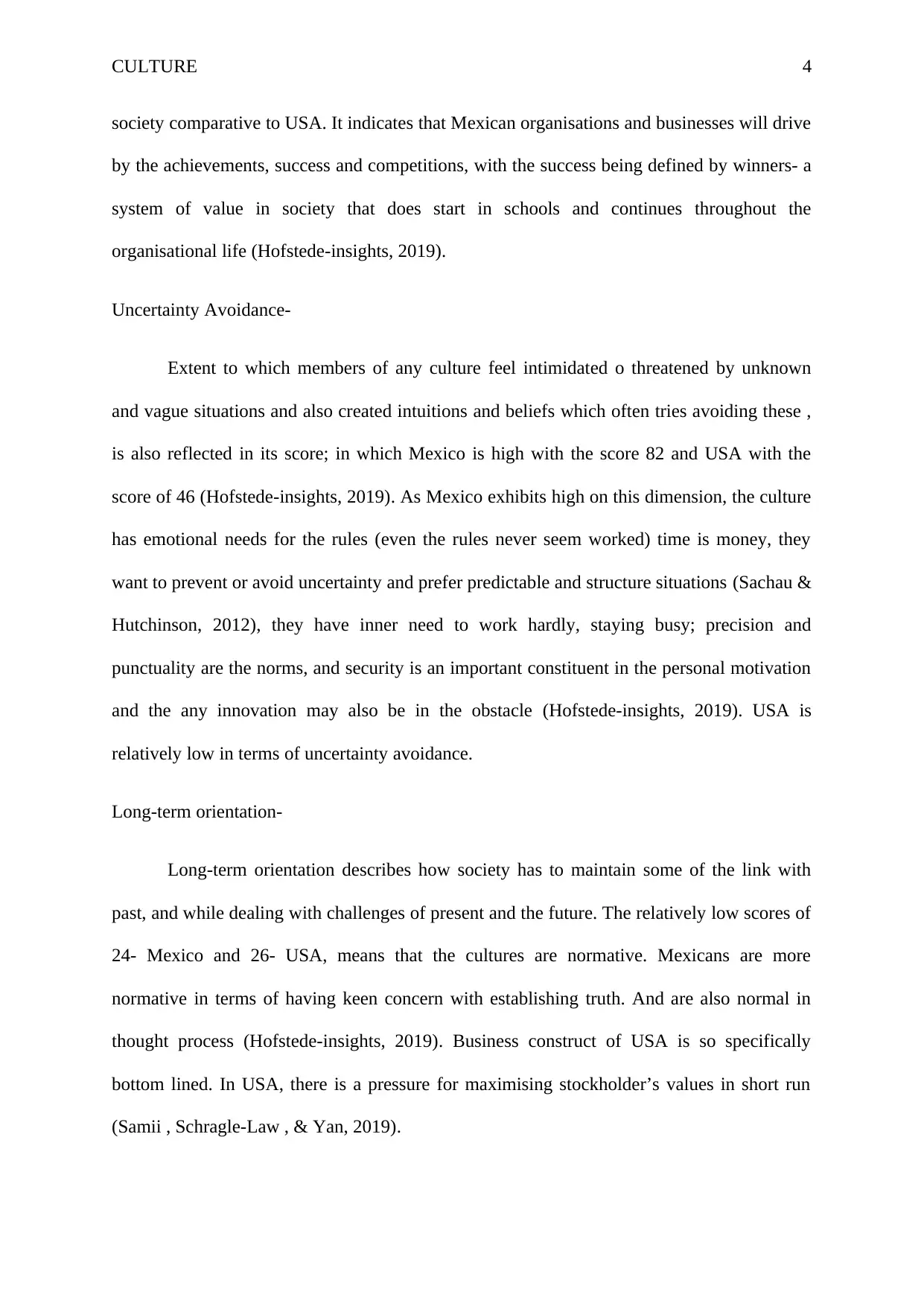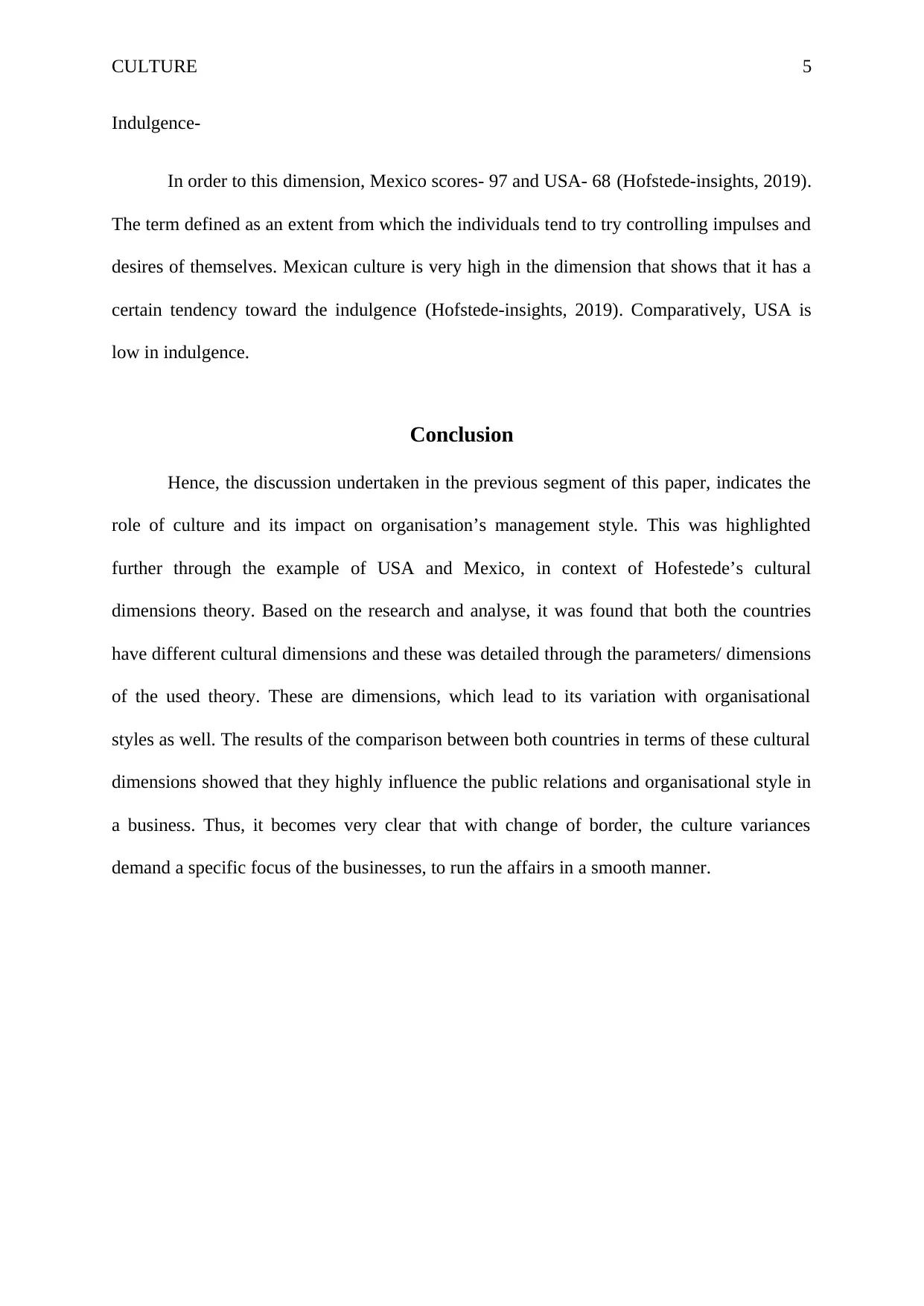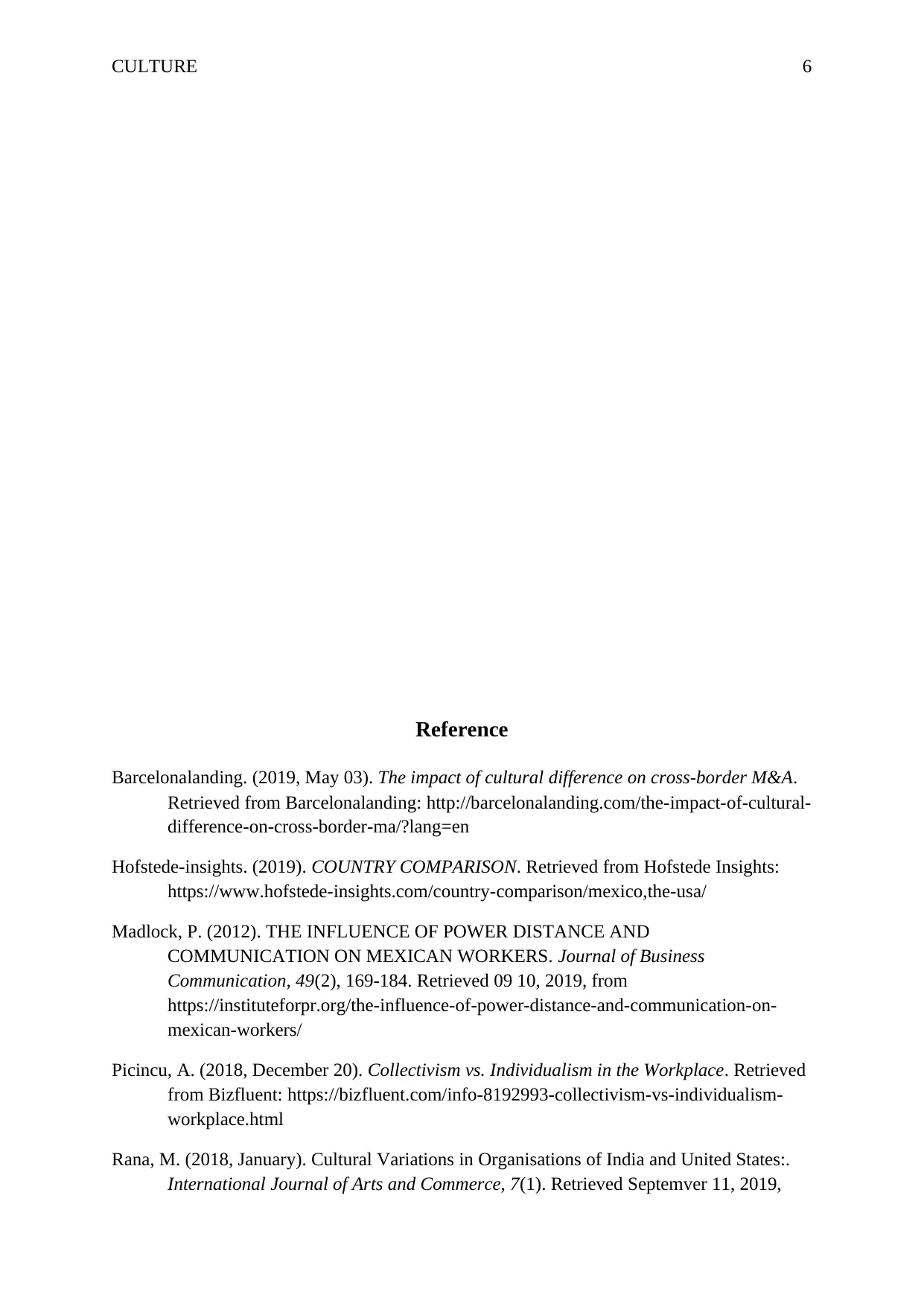Culture Variance Report on USA and Mexico, Business Operations
VerifiedAdded on 2022/12/05
|8
|1440
|464
Report
AI Summary
This report examines the concept of culture variance, specifically focusing on the differences between the United States and Mexico. It highlights the impact of these cultural variances on business operations, emphasizing the importance of understanding these differences for successful cross-border business activities. The report utilizes Hofstede's Cultural Dimensions Theory to compare the two countries across six dimensions: Power Distance, Individualism, Masculinity, Uncertainty Avoidance, Long-term Orientation, and Indulgence. It analyzes how these dimensions influence various aspects of business, including public relations, organizational structure, and communication styles. The findings reveal significant differences in cultural values and their implications for managing businesses in each country, emphasizing the need for tailored strategies to navigate these variances effectively. The report concludes by underscoring the critical role of cultural awareness in achieving organizational goals across international borders.

Running Head: CULTURE 0
Student Name:
Student University:
CULTURE VARIANCE
Student Name:
Student University:
CULTURE VARIANCE
Paraphrase This Document
Need a fresh take? Get an instant paraphrase of this document with our AI Paraphraser

CULTURE 1
Table of Contents
Introduction................................................................................................................................2
Cross Border Influence..............................................................................................................2
USA and Mexico: Cross Border Culture Variance....................................................................2
Hofestede’s Culture Dimensions Theory...............................................................................3
Conclusion..................................................................................................................................5
Reference....................................................................................................................................6
Table of Contents
Introduction................................................................................................................................2
Cross Border Influence..............................................................................................................2
USA and Mexico: Cross Border Culture Variance....................................................................2
Hofestede’s Culture Dimensions Theory...............................................................................3
Conclusion..................................................................................................................................5
Reference....................................................................................................................................6

CULTURE 2
Introduction
Culture difference in crossing borders is referred to as culture variance. Culture
variance takes place when the people from different part of the world are very different from
one another but in the similar ways, they are very similar to one another. There is a variance
in between the culture of the countries, USA and Mexico. There is a big role of culture
variations in terms of Business operations. This paper describes the varieties of culture in
USA and Mexico, and also highlights the manner in which they make significant impact on
the business organisation.
Cross Border Influence
Organisational culture gives clearer understanding on a company’s way of doing
business (Barcelonalanding, 2019). The cross border culture provides variation to the
operating activities and specific criteria to the business, as running business across the border
give a chance to understand and analyse the norms of business culture and as well as the
employees’ perception toward the work in terms to regulate things properly.
USA and Mexico: Cross Border Culture Variance
The variance and culture in business and organisations differs with every border
crossed (Rana, 2018). USA and Mexico are the countries next to each other, but they are
different in terms of culture. Thus, each business aspect has to be undertaken carefully,
particularly by understanding these differences and variances. For instance, the
Implementation of Public Relation Campaigns in USA and Mexico presents certain
challenges. The organisational functions like Research, communication dialogue, planning
and evaluation; are influenced by various dimensions of culture implemented in Public
Introduction
Culture difference in crossing borders is referred to as culture variance. Culture
variance takes place when the people from different part of the world are very different from
one another but in the similar ways, they are very similar to one another. There is a variance
in between the culture of the countries, USA and Mexico. There is a big role of culture
variations in terms of Business operations. This paper describes the varieties of culture in
USA and Mexico, and also highlights the manner in which they make significant impact on
the business organisation.
Cross Border Influence
Organisational culture gives clearer understanding on a company’s way of doing
business (Barcelonalanding, 2019). The cross border culture provides variation to the
operating activities and specific criteria to the business, as running business across the border
give a chance to understand and analyse the norms of business culture and as well as the
employees’ perception toward the work in terms to regulate things properly.
USA and Mexico: Cross Border Culture Variance
The variance and culture in business and organisations differs with every border
crossed (Rana, 2018). USA and Mexico are the countries next to each other, but they are
different in terms of culture. Thus, each business aspect has to be undertaken carefully,
particularly by understanding these differences and variances. For instance, the
Implementation of Public Relation Campaigns in USA and Mexico presents certain
challenges. The organisational functions like Research, communication dialogue, planning
and evaluation; are influenced by various dimensions of culture implemented in Public
⊘ This is a preview!⊘
Do you want full access?
Subscribe today to unlock all pages.

Trusted by 1+ million students worldwide

CULTURE 3
Relations campaign in these countries where publics refer to the employees, investors,
customers and general public.
Hofestede’s Culture Dimensions Theory
To better understand these cross border variances the Hofestede’s Culture Dimensions
Theory proves to be of help. There are different aspects to compare both countries, Mexico
and USA through Hofestede’s theory, which are as follows:
Power Distance-
According to the comparison between both countries, it has found that Mexico has
more power difference than USA. As per the data, it is 80 in Mexico and 40 in USA
(Hofstede-insights, 2019). It means that in the organisations of Mexico, the result showed that
employees have experienced the anxiety and consciousness in communicating with the
others; they used more of strategic communication (i.e. compliments) (Madlock, 2012).
Individualism-
In comparison with Mexico (score-30), USA is high (score-91) in individualism
(Hofstede-insights, 2019). Mexico is a society of collectivist in which people do belongs to
the ’in groups’ what takes care of them exchanging for the loyalty. That means that there,
people in the business organisations Mexico, tend to work in groups and are proved to
reliable to each other. On the other side, people in the organisations of USA, are being taught
to become self-dependant and making decisions by their own self. Thus, they are
individualist (Picincu, 2018).
Masculinity-
In terms of Masculinity, both countries’ score, Mexico and USA, has a little
difference of 69-Mexico, 62-USA (Hofstede-insights, 2019). Thus, Mexico is a Masculine
Relations campaign in these countries where publics refer to the employees, investors,
customers and general public.
Hofestede’s Culture Dimensions Theory
To better understand these cross border variances the Hofestede’s Culture Dimensions
Theory proves to be of help. There are different aspects to compare both countries, Mexico
and USA through Hofestede’s theory, which are as follows:
Power Distance-
According to the comparison between both countries, it has found that Mexico has
more power difference than USA. As per the data, it is 80 in Mexico and 40 in USA
(Hofstede-insights, 2019). It means that in the organisations of Mexico, the result showed that
employees have experienced the anxiety and consciousness in communicating with the
others; they used more of strategic communication (i.e. compliments) (Madlock, 2012).
Individualism-
In comparison with Mexico (score-30), USA is high (score-91) in individualism
(Hofstede-insights, 2019). Mexico is a society of collectivist in which people do belongs to
the ’in groups’ what takes care of them exchanging for the loyalty. That means that there,
people in the business organisations Mexico, tend to work in groups and are proved to
reliable to each other. On the other side, people in the organisations of USA, are being taught
to become self-dependant and making decisions by their own self. Thus, they are
individualist (Picincu, 2018).
Masculinity-
In terms of Masculinity, both countries’ score, Mexico and USA, has a little
difference of 69-Mexico, 62-USA (Hofstede-insights, 2019). Thus, Mexico is a Masculine
Paraphrase This Document
Need a fresh take? Get an instant paraphrase of this document with our AI Paraphraser

CULTURE 4
society comparative to USA. It indicates that Mexican organisations and businesses will drive
by the achievements, success and competitions, with the success being defined by winners- a
system of value in society that does start in schools and continues throughout the
organisational life (Hofstede-insights, 2019).
Uncertainty Avoidance-
Extent to which members of any culture feel intimidated o threatened by unknown
and vague situations and also created intuitions and beliefs which often tries avoiding these ,
is also reflected in its score; in which Mexico is high with the score 82 and USA with the
score of 46 (Hofstede-insights, 2019). As Mexico exhibits high on this dimension, the culture
has emotional needs for the rules (even the rules never seem worked) time is money, they
want to prevent or avoid uncertainty and prefer predictable and structure situations (Sachau &
Hutchinson, 2012), they have inner need to work hardly, staying busy; precision and
punctuality are the norms, and security is an important constituent in the personal motivation
and the any innovation may also be in the obstacle (Hofstede-insights, 2019). USA is
relatively low in terms of uncertainty avoidance.
Long-term orientation-
Long-term orientation describes how society has to maintain some of the link with
past, and while dealing with challenges of present and the future. The relatively low scores of
24- Mexico and 26- USA, means that the cultures are normative. Mexicans are more
normative in terms of having keen concern with establishing truth. And are also normal in
thought process (Hofstede-insights, 2019). Business construct of USA is so specifically
bottom lined. In USA, there is a pressure for maximising stockholder’s values in short run
(Samii , Schragle-Law , & Yan, 2019).
society comparative to USA. It indicates that Mexican organisations and businesses will drive
by the achievements, success and competitions, with the success being defined by winners- a
system of value in society that does start in schools and continues throughout the
organisational life (Hofstede-insights, 2019).
Uncertainty Avoidance-
Extent to which members of any culture feel intimidated o threatened by unknown
and vague situations and also created intuitions and beliefs which often tries avoiding these ,
is also reflected in its score; in which Mexico is high with the score 82 and USA with the
score of 46 (Hofstede-insights, 2019). As Mexico exhibits high on this dimension, the culture
has emotional needs for the rules (even the rules never seem worked) time is money, they
want to prevent or avoid uncertainty and prefer predictable and structure situations (Sachau &
Hutchinson, 2012), they have inner need to work hardly, staying busy; precision and
punctuality are the norms, and security is an important constituent in the personal motivation
and the any innovation may also be in the obstacle (Hofstede-insights, 2019). USA is
relatively low in terms of uncertainty avoidance.
Long-term orientation-
Long-term orientation describes how society has to maintain some of the link with
past, and while dealing with challenges of present and the future. The relatively low scores of
24- Mexico and 26- USA, means that the cultures are normative. Mexicans are more
normative in terms of having keen concern with establishing truth. And are also normal in
thought process (Hofstede-insights, 2019). Business construct of USA is so specifically
bottom lined. In USA, there is a pressure for maximising stockholder’s values in short run
(Samii , Schragle-Law , & Yan, 2019).

CULTURE 5
Indulgence-
In order to this dimension, Mexico scores- 97 and USA- 68 (Hofstede-insights, 2019).
The term defined as an extent from which the individuals tend to try controlling impulses and
desires of themselves. Mexican culture is very high in the dimension that shows that it has a
certain tendency toward the indulgence (Hofstede-insights, 2019). Comparatively, USA is
low in indulgence.
Conclusion
Hence, the discussion undertaken in the previous segment of this paper, indicates the
role of culture and its impact on organisation’s management style. This was highlighted
further through the example of USA and Mexico, in context of Hofestede’s cultural
dimensions theory. Based on the research and analyse, it was found that both the countries
have different cultural dimensions and these was detailed through the parameters/ dimensions
of the used theory. These are dimensions, which lead to its variation with organisational
styles as well. The results of the comparison between both countries in terms of these cultural
dimensions showed that they highly influence the public relations and organisational style in
a business. Thus, it becomes very clear that with change of border, the culture variances
demand a specific focus of the businesses, to run the affairs in a smooth manner.
Indulgence-
In order to this dimension, Mexico scores- 97 and USA- 68 (Hofstede-insights, 2019).
The term defined as an extent from which the individuals tend to try controlling impulses and
desires of themselves. Mexican culture is very high in the dimension that shows that it has a
certain tendency toward the indulgence (Hofstede-insights, 2019). Comparatively, USA is
low in indulgence.
Conclusion
Hence, the discussion undertaken in the previous segment of this paper, indicates the
role of culture and its impact on organisation’s management style. This was highlighted
further through the example of USA and Mexico, in context of Hofestede’s cultural
dimensions theory. Based on the research and analyse, it was found that both the countries
have different cultural dimensions and these was detailed through the parameters/ dimensions
of the used theory. These are dimensions, which lead to its variation with organisational
styles as well. The results of the comparison between both countries in terms of these cultural
dimensions showed that they highly influence the public relations and organisational style in
a business. Thus, it becomes very clear that with change of border, the culture variances
demand a specific focus of the businesses, to run the affairs in a smooth manner.
⊘ This is a preview!⊘
Do you want full access?
Subscribe today to unlock all pages.

Trusted by 1+ million students worldwide

CULTURE 6
Reference
Barcelonalanding. (2019, May 03). The impact of cultural difference on cross-border M&A.
Retrieved from Barcelonalanding: http://barcelonalanding.com/the-impact-of-cultural-
difference-on-cross-border-ma/?lang=en
Hofstede-insights. (2019). COUNTRY COMPARISON. Retrieved from Hofstede Insights:
https://www.hofstede-insights.com/country-comparison/mexico,the-usa/
Madlock, P. (2012). THE INFLUENCE OF POWER DISTANCE AND
COMMUNICATION ON MEXICAN WORKERS. Journal of Business
Communication, 49(2), 169-184. Retrieved 09 10, 2019, from
https://instituteforpr.org/the-influence-of-power-distance-and-communication-on-
mexican-workers/
Picincu, A. (2018, December 20). Collectivism vs. Individualism in the Workplace. Retrieved
from Bizfluent: https://bizfluent.com/info-8192993-collectivism-vs-individualism-
workplace.html
Rana, M. (2018, January). Cultural Variations in Organisations of India and United States:.
International Journal of Arts and Commerce, 7(1). Retrieved Septemver 11, 2019,
Reference
Barcelonalanding. (2019, May 03). The impact of cultural difference on cross-border M&A.
Retrieved from Barcelonalanding: http://barcelonalanding.com/the-impact-of-cultural-
difference-on-cross-border-ma/?lang=en
Hofstede-insights. (2019). COUNTRY COMPARISON. Retrieved from Hofstede Insights:
https://www.hofstede-insights.com/country-comparison/mexico,the-usa/
Madlock, P. (2012). THE INFLUENCE OF POWER DISTANCE AND
COMMUNICATION ON MEXICAN WORKERS. Journal of Business
Communication, 49(2), 169-184. Retrieved 09 10, 2019, from
https://instituteforpr.org/the-influence-of-power-distance-and-communication-on-
mexican-workers/
Picincu, A. (2018, December 20). Collectivism vs. Individualism in the Workplace. Retrieved
from Bizfluent: https://bizfluent.com/info-8192993-collectivism-vs-individualism-
workplace.html
Rana, M. (2018, January). Cultural Variations in Organisations of India and United States:.
International Journal of Arts and Commerce, 7(1). Retrieved Septemver 11, 2019,
Paraphrase This Document
Need a fresh take? Get an instant paraphrase of this document with our AI Paraphraser

CULTURE 7
from
https://pdfs.semanticscholar.org/6b82/0565edcf29c577e944d25da83b2e17d472c8.pdf
Sachau, L., & Hutchinson, S. (2012, December). Trends in culturally relevant interface
design features for Latino Web site users. Springer, 60(6), 1033–1050. Retrieved
September 11, 2019, from https://link.springer.com/article/10.1007/s11423-012-9270-
5
Samii , M., Schragle-Law , S., & Yan, C. (2019). A CULTURAL ANALYSIS OF
MANAGEMENT STYLES: THE UNITED STATES WITH A NEW GENERATION OF
MANAGERS IN. Retrieved from Semanticscholar:
https://pdfs.semanticscholar.org/a3c2/26c80a3b20a69ab940780f8848613a83159f.pdf
from
https://pdfs.semanticscholar.org/6b82/0565edcf29c577e944d25da83b2e17d472c8.pdf
Sachau, L., & Hutchinson, S. (2012, December). Trends in culturally relevant interface
design features for Latino Web site users. Springer, 60(6), 1033–1050. Retrieved
September 11, 2019, from https://link.springer.com/article/10.1007/s11423-012-9270-
5
Samii , M., Schragle-Law , S., & Yan, C. (2019). A CULTURAL ANALYSIS OF
MANAGEMENT STYLES: THE UNITED STATES WITH A NEW GENERATION OF
MANAGERS IN. Retrieved from Semanticscholar:
https://pdfs.semanticscholar.org/a3c2/26c80a3b20a69ab940780f8848613a83159f.pdf
1 out of 8
Related Documents
Your All-in-One AI-Powered Toolkit for Academic Success.
+13062052269
info@desklib.com
Available 24*7 on WhatsApp / Email
![[object Object]](/_next/static/media/star-bottom.7253800d.svg)
Unlock your academic potential
Copyright © 2020–2025 A2Z Services. All Rights Reserved. Developed and managed by ZUCOL.





